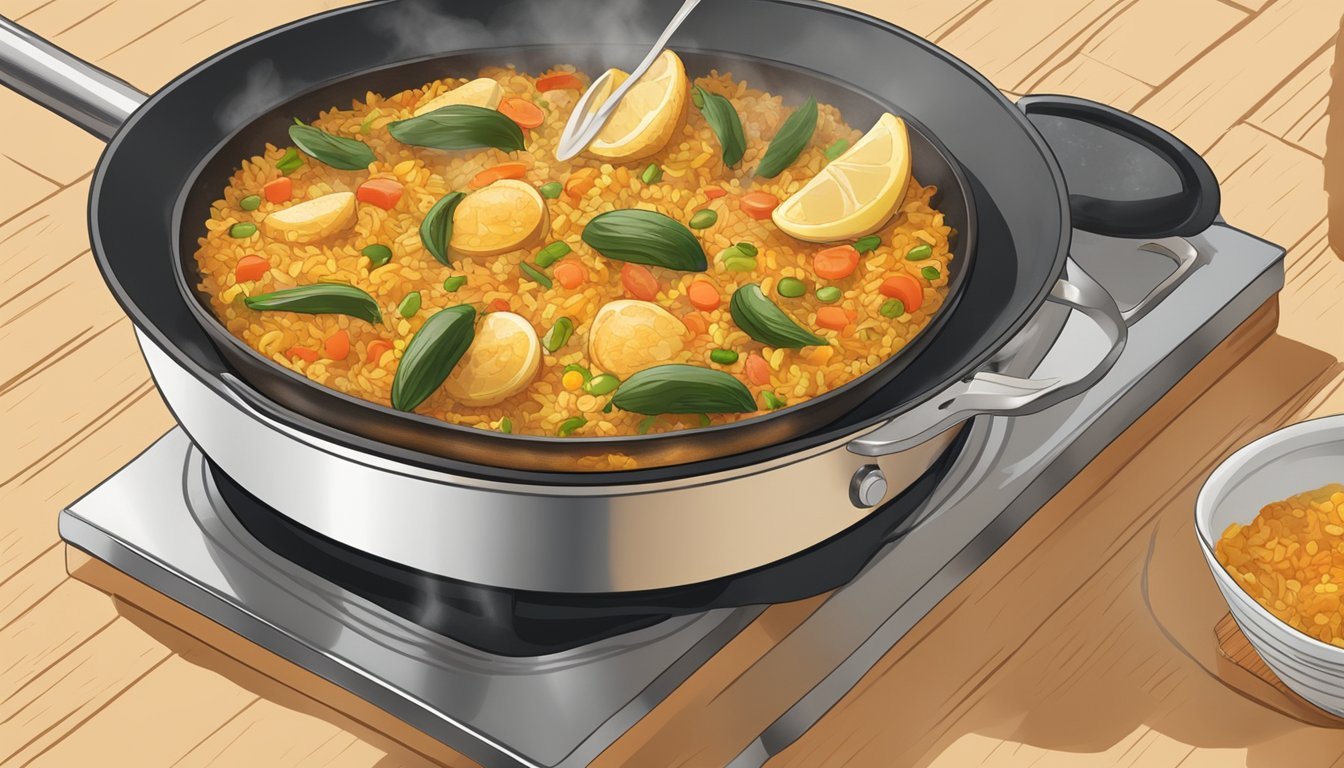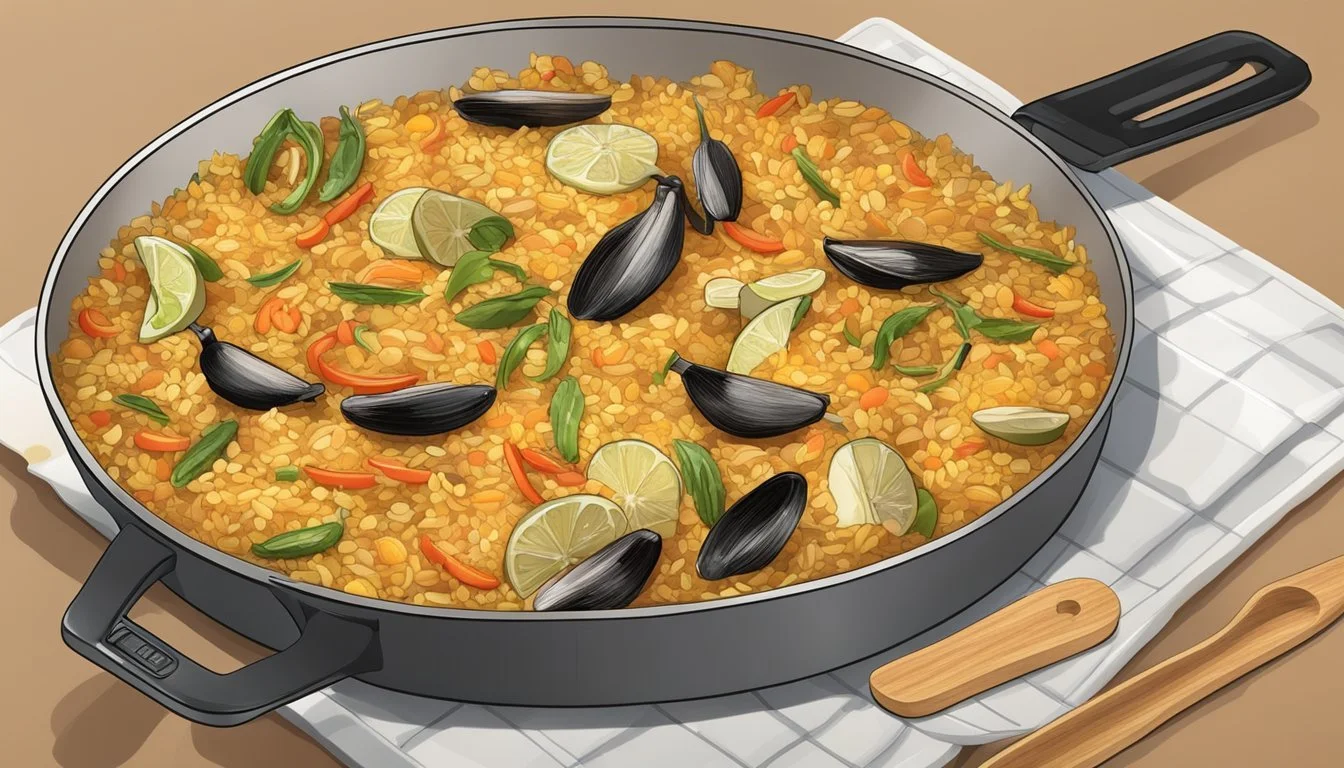How to Reheat Gluten-Free Paella
Best Methods and Tips
When it comes to enjoying the rich and savory flavors of gluten-free paella, reheating it properly is essential to maintaining its taste and texture. One effective method is to use the oven, preheating it to 350℉ and adding a half cup of water to the paella, then cooking it for 20-25 minutes. This retains the original flavor and moisture, giving you a dish that's almost as delightful as when it was first made.
For those in a hurry, the microwave offers a swift alternative. Transferring the paella to a microwave-safe container and covering it with a damp paper towel, heating for 2-3 minutes while stirring every 30 seconds ensures it's evenly warmed without drying out.
Using a stovetop pan can yield excellent results too. Adding a bit of stock or water to a heavy-bottomed pan and gently warming the paella for 4-5 minutes with the lid on, and stirring occasionally, will reintroduce moisture and heat the dish evenly. This approach delivers a well-rounded flavor profile, perfect for satisfying those paella cravings.
Understanding Gluten-Free Paella
A gluten-free paella ensures a safe and delightful dining experience for those with gluten sensitivities. We will examine critical components like essential ingredients and the significance of the paella pan in creating an authentic gluten-free version.
Key Ingredients for a Gluten-Free Paella
When crafting gluten-free paella, selecting the right ingredients is crucial. Rice is the foundation; bomba and arborio rice are excellent choices due to their ability to absorb flavors while maintaining texture. Saffron and smoked paprika are essential for authentic flavor and rich color.
For proteins, options include chicken, seafood (like shrimps and mussels), and chorizo. Vegetables such as bell peppers, peas, and tomatoes add nutritional value and color. Ensuring all ingredients are certified gluten-free prevents cross-contamination. In vegan adaptations, proteins can be replaced with beans or tofu.
Importance of the Paella Pan
The paella pan plays a pivotal role in cooking. Its wide, shallow design ensures even heat distribution, which is essential for cooking rice uniformly. The pan's shape also helps achieve the beloved socarrat, the crispy, caramelized layer of rice at the bottom.
Using a traditional paella pan not only enhances texture but also embodies the authentic cooking experience. Heating the pan properly before adding ingredients is critical; this helps in achieving perfect consistency without burning or undercooking any part of the dish.
Preparation Before Reheating
Properly storing gluten-free paella and selecting an appropriate reheating method are crucial for preserving its flavor and texture. Below, critical steps are outlined to guide this process.
Storing Leftover Paella
For leftovers, refrigeration is key. Transfer the paella to an airtight container and place it in the fridge within two hours of cooking to avoid bacterial growth. Use a shallow container to ensure even cooling. If you plan to keep it for longer, freezing is an option. Seal the paella in a freezer-safe bag or container, removing as much air as possible. Label the container with the date to keep track of freshness.
Choosing the Right Reheating Method
The reheating method impacts the texture and temperature of the paella. For a quick option, the microwave can be used. Place the paella in a microwave-safe dish, cover with a damp paper towel, and heat in 30-second intervals, stirring to ensure even warming.
For a more authentic taste, the stovetop method is recommended. Heat olive oil in a non-stick pan over medium heat and add the paella. Sprinkle a tablespoon of water around the edges to retain moisture. Stir occasionally and cook until hot.
Using an oven is another effective method. Preheat the oven to 350°F, place the paella in an oven-safe dish, and cover with tin foil. Adding lemon juice before baking can enhance flavor. Bake for about 20-25 minutes, checking occasionally to prevent over-drying.
Reheating Gluten-Free Paella on the Stovetop
To reheat gluten-free paella on the stovetop, start by selecting a heavy-bottomed pan. Preheat the pan over medium heat for a few minutes.
Drizzle 1-2 tablespoons of olive oil into the pan for an even coating. This helps prevent the rice from sticking and enhances the texture.
Next, add 2-3 tablespoons of gluten-free chicken broth or water. This extra liquid is crucial to keep the paella moist.
Place the leftover paella into the pan. Stir gently to combine with the broth, ensuring even distribution.
Cover the pan with a lid to lock in the steam. Heat the paella for about 4-5 minutes. Stir occasionally to avoid burning and to ensure even heating.
Check the temperature and ensure the paella is thoroughly heated before serving.
Reheating Gluten-Free Paella in the Oven
Preheat the oven to 350℉. Using this temperature ensures even heat distribution without drying out the paella.
Transfer the gluten-free paella to a shallow baking dish. A paellera or any traditional wide pan works best.
Add about a half cup of gluten-free chicken broth to maintain moisture. This prevents the rice from becoming dry and enhances the flavor.
Cover the dish tightly with aluminum foil to trap the steam. This step is essential for keeping the paella moist during reheating.
Place the covered dish in the oven and heat for 20-25 minutes.
Check the paella halfway through to ensure it is heating evenly. Stir gently if necessary.
After reheating, let the dish sit for a couple of minutes before serving.
Using these steps, reheating gluten-free paella in the oven will keep it flavorful and moist.
Reheating Gluten-Free Paella in the Microwave
To reheat gluten-free paella in the microwave, start by placing a portion of paella in a microwave-safe dish. If the dish contains seafood or large chunks of vegetables, consider removing them to ensure even heating.
Cover the dish with a microwave-safe lid or microwave-safe cling film. Covering the food helps retain moistness and prevents it from drying out.
Steps:
Place the paella in the microwave.
Set the microwave to medium-high heat.
Heat for 2-3 minutes initially.
Stir gently using a fork or spoon for even distribution of heat.
If the paella appears dry, add a small amount of gluten-free chicken broth before reheating. This simple trick can enhance the texture and flavor.
Tips for Best Results:
Stir midway: Halfway through reheating, stir the paella to ensure all parts are evenly warmed.
Avoid overcooking: Check the paella periodically to avoid overcooking or overheating.
Using these methods ensures the gluten-free paella remains delicious and moist.
Finishing Touches After Reheating
After reheating gluten-free paella, adding finishing touches can enhance both its texture and flavor. These final steps will ensure your paella tastes just as delicious as when it was first cooked.
Restoring the Crispness of the Socarrat
The socarrat, the crispy layer at the bottom of the paella, is a prized component. To restore its crispness, heat the paella pan over medium heat.
Drizzle a small amount of olive oil around the edges of the pan. Let it heat until it begins to shimmer. Carefully place the reheated paella back in the pan, pressing it gently with a spatula.
Allow the paella to cook undisturbed for a few minutes until a crispy layer forms. Check occasionally to avoid burning. This technique enhances the socarrat, giving it a delightful crunch.
Enhancing the Flavor Profile
To elevate the flavor of your reheated paella, consider adding a few fresh ingredients. Lemon wedges can be served on the side, allowing diners to squeeze fresh lemon juice over their portions.
Sprinkle freshly chopped parsley for a burst of color and fresh aroma. If the paella contains seafood, a light drizzle of olive oil can enhance its richness.
Finishing with a sprinkle of sea salt can also bring out the natural flavors of the ingredients. Adjust these additions based on personal preference to create a well-balanced and delicious dish.
Gluten-Free Paella Variations
Exploring gluten-free paella variations can lead to delightful culinary experiences. Whether you prefer vegetarian, vegan, or protein-rich options, the flexibility of ingredients allows you to craft a dish suited to your taste and dietary needs.
Vegetarian and Vegan Paella Options
For those seeking plant-based alternatives, a vegetarian or vegan paella can be both satisfying and flavorful. Key ingredients often include bell peppers, artichoke hearts, green beans, and tomatoes.
Vegetarian variants may feature protein-rich options like chickpeas or tofu.
Spices such as saffron, paprika, and turmeric provide depth and color, creating a vibrant dish. Extra virgin olive oil is essential for sautéing vegetables to enhance their natural flavors.
Without any seafood or meat, these dishes can retain the authentic essence of paella while catering to vegetarian preferences.
Protein Alternatives
For a heartier meal, various protein sources can be used in gluten-free paella. Chicken, shrimp, and mussels are popular choices, each bringing unique textures and tastes.
Chorizo sausages can add a spicy kick, while beans such as white beans or black-eyed peas can offer a nutritious boost for those avoiding meat.
Combining proteins like chicken and shrimp can create a richer flavor profile.
Using saffron and oregano enhances these ingredients, maintaining a traditional paella taste.
Adjusting Spices and Herbs
Adjusting spices and herbs in gluten-free paella recipes can elevate the dish’s authenticity and flavor. The classic combination includes saffron, turmeric, black pepper, and cayenne pepper.
Oregano and smoked paprika can add a fragrant, earthy note.
For a spicier option, increase the amount of cayenne pepper.
Balancing the spices ensures the dish remains aromatic and pleasing to the palate.
Whether you’re using seafood, chicken, or vegetables, the right blend of spices will harmonize with your ingredients, creating a balanced and delicious paella.
Health and Dietary Considerations
Reheating gluten-free paella while maintaining its nutritional value is important, especially for those with dietary restrictions.
Nutritional Benefits:
Protein: Paella often contains seafood, chicken, or both, which are excellent sources of protein. This makes it a hearty option.
Fiber: The vegetables included, such as bell peppers and peas, contribute essential fiber.
Calories: Gluten-free paella tends to be relatively low in calories, especially when compared to its traditional counterpart. This is particularly beneficial for those monitoring their caloric intake.
Gluten-Free Assurance: Ensure all ingredients, including spices and broth, are certified gluten-free to prevent cross-contamination. This is crucial for individuals with celiac disease or gluten sensitivity.
For kids, gluten-free paella can serve as a healthy meal option. Its vibrant mix of proteins and vegetables encourages a balanced diet without sacrificing flavor.
Maintaining a gluten-free diet doesn't mean sacrificing taste or nutritional benefits. Reheating methods that preserve moisture and texture ensure a delicious and nutritious meal.
Serving and Presentation
When serving gluten-free paella, visual appeal is just as important as its taste. Using a wide and shallow dish can help showcase the vibrant colors of the dish.
To add a pop of color and a zesty kick, serve the paella with lemon wedges on the side. This not only enhances the flavor but also adds a touch of brightness to the presentation.
Saffron threads can be sprinkled on the top before serving. This elevates the dish both in terms of appearance and aroma, highlighting the traditional ingredients used in paella.
Garnish with finely chopped fresh parsley for a fresh and herbal note. This adds a dash of green, providing a lovely contrast to the golden saffron-infused rice.
Adding slices of red bell pepper not only boosts the nutritional value but also adds vibrant red hues, making the dish visually appealing. Arrange them artfully around the rice or mix them into the dish for a colorful presentation.
To keep the paella warm and appealing, serve it immediately after reheating. This ensures that it maintains its rich texture and robust flavors, making it the perfect comfort food for any occasion.
For a more interactive dining experience, consider serving paella in the traditional paellera (pan). This not only enhances authenticity but also allows guests to appreciate the shared meal style and communal aspect of paella.







